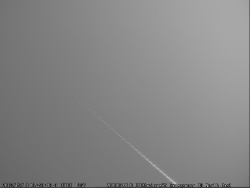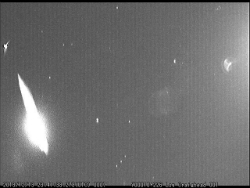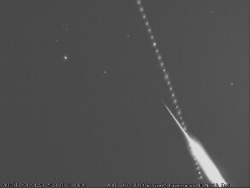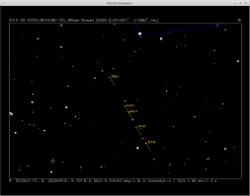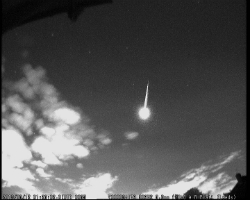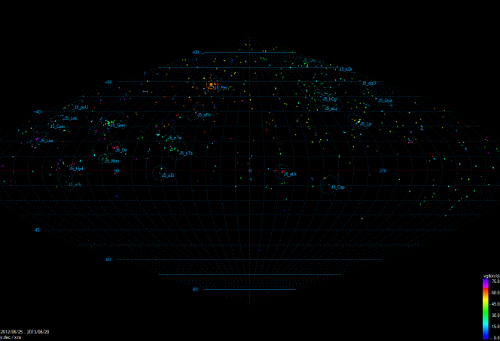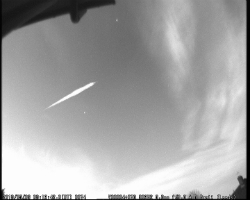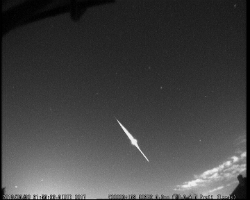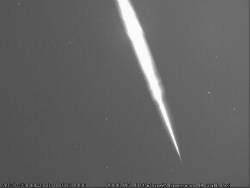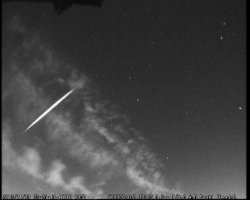Welcome to NEMETODE
Network for Meteor
Triangulation and Orbit Determination
Home: 2013
NEMETODE is a network of cameras based in the British Isles that monitor the night sky for meteors ("shooting stars"). Through the use of triangulation and timing the network is able to determine the actual trajectory and velocity of the meteoroids as they pass through the Earth's atmosphere. From this we are able to determine specific characteristics such as the radiant (that point in the sky from which each meteor appears to originate), how the position of this radiant varies with time and the parameters of the original solar orbit of the meteoroid (before the earth got in the way). We analyse our own data as we find this is an excellent feedback mechanism that deepens our understanding of the subject and enables us to optimise our detection capabilities. Our results are published in peer reviewed journals such as the Journal of the British Astronomical Association and WGN, the Journal of the International Meteor Organisation. Having completed our analysis, our data is uploaded to EDMOND for consolidation with other European groups. While we have excellent coverage over certain parts of the British Isles, there are still many gaps so please get in touch if you are interested in joining the group.
This page is the archive of the 2013 entries on the NEMETODE homepage. Other years can be accessed by clicking on the links below.
19th December 2013: Pre-Dawn Fireball?: On 19th December 2013 at 07:58 GMT a bright meteor was observed over the UK - reports soon started to appear on Twitter (initial consolidated list here) and on the Armagh Fireball Report Page. Most meteor cameras across the UK had by this time shut down due to the imminent sunrise but NEMETODE cameras operated by Alex Pratt in Leeds and William Stewart in Ravensmoor were still operating and captured the early stages of the event. Alex's camera commenced automatic shutdown 71 seconds after the meteor occurred! Videos, details and an analysis are available here.
The meteor was continuing to brighten as it exited the field of view of both cameras and hence the maximum magnitude achieved and the extent to which the meteor continued beyond the end of the shown ground track cannot be determined from the videos. The visual reports suggest that it was sufficiently bright to be classed as a fireball while some reports suggest that it was still visible as it passed over the coastline and out into the North Sea.
Further analysis to follow. In the meantime visual observers are strongly encouraged to submit their reports to the Armagh Fireball Report Page. Of particular interest will be the observer's location, the cardinal direction at which the meteor faded to invisibility, the angle above the horizon at which it faded to invisibility and an estimate of the maximum brightness of the meteor in comparison to, for example, the Moon or Venus. While the videos provide good information relating to the start of the meteor trail, the visual reports will be essential in determining the maximum brightness and whether or not the meteor did indeed pass over the coast and out to sea.
14th December 2013: Geminids Hit the Headlines: The night of 13th / 14th December 2013 has proved to have been extremely busy with well in excess of 1200 individual meteor detections by NEMETODE. Sky News have been running some NEMETODE Geminid videos from last night on their rolling news programme and on their website. It will take some time to complete the analysis of all of the detections ... as a taster the image below relates to a bright Geminid meteor observed at on 13th December 2013 at 23:41:38 GMT that was imaged from three NEMETODE nodes. This is why the network exists: it is by imaging the same event from different locations that we are able to determine, among other things, the ground track and original solar orbit. Videos, details and an analysis are available here. Enjoy the show!
09th December 2013: NEMETODE more than doubles in size and becomes an International Collaboration: We're very proud to announce that in recent weeks three additional experienced meteor observers have joined NEMETODE and as a consequence we have significantly increased our coverage and capability. In addition to David Anderson's observatory in SW Scotland, we also now have observations from Mike Foylan and Michael O'Connell from the Republic of Ireland. Alex Pratt has also deployed a second camera from his location in West Yorkshire. Additional details and an updated coverage map are available here. A very warm welcome to David, Mike and Michael.
30th November 2013: Green Fireball over Macclesfield: We have received reports of a "Green Fireball over Macclesfield, Cheshire" on 29th November 2013 at 21:00:04 GMT ... videos, details and an analysis are available here.
24th November 2013: Latest Papers. Our latest paper, "Taurids 2012 - Dual-Station Meteor Videography", has just been accepted for journal publication. We've a few more in peer review and additional ones in draft. In the meantime our papers "Geminids 2012 - Multi-Station Meteor Videography" and "A Modern Video Meteor Detection System and Network - Overview and Typical Costs" have been published in the December 2013 issue of the Journal of the British Astronomical Association. See here for additional details. We're now working through our data for October and November!
18th September 2013: Yaogan 17 Deployment Video. In the early hours of 02nd September 2013, the Ravensmoor South East camera made a serendipitous recording of the deployment of the three payload elements of the Chinese reconnaissance satellite Yaogan 17 - a video, detals and analysis is available here.
10th September 2013: September Perseids Outburst? Reports are coming in that on 09th September 2013 between 22.00 and 23.00 UTC there was a spike in the frequency and brightness of the September Perseid (SPE) meteors. References include the IMO Flux Viewer, IMO-News, MeteorObs and Spaceweather. NEMETODE also recorded this outburst. Between 20:00 and 04:00 UTC the NEMETODE cameras recorded 23 individual SPE meteors. A total of 14 SPEs were captured between 22:00 and 23:00 UTC (compared with a predicted maximum ZHR of 5), 3 of which were dual-station events. Capture and analysis was performed using SonotaCo's UFO program suite, with the following provisional results:
| Solar Longitude of Outburst Peak: | 167.2 |
| Absolute Magnitudes of the three dual station captures: | -2.9, -2.7, -1.0 |
| Average Vg: | 64.6 +/- 4.8 km/s |
| Radiant (corrected for Zenithal Attraction): | RA 049.3, DEC +39.4 |
| a | 8.494 |
| q | 0.708 |
| e | 0.917 |
| p | 24.763 |
| peri | 247.698 |
| node | 167.190 |
| incl | 140.018 |
NEMETODE will complete a fuller analysis against the background of the overall shower in the comng weeks.
12th August 2013: The Case of the Name Changing Fireball: This magnitude -5.6 fireball appeared on 12th August 2013 at 01:26:02 GMT / 02:26:02 BST. Initial indications were that it was either a Kappa Cygnid or an August Draconid though further analysis revealed that it was in fact a sporadic. With so many meteor showers (both confirmed and unconfirmed), this example demonstrates the value of a network dedicated to meteor trajectory triangulation. Videos, details and an analysis are available here.
28th July 2013: Our 1st Birthday (well, sort of). As NEMETODE celebrates its first birthday as a fully operational multi-station group, we thought it would be a good time to look back on our results over the past twelve months. As many of you will know, the weather in the latter half of 2012 was somewhat less than ideal and this had a significant impact on the quality and quantity of detections over the busiest time of the year for shower meteors. The plot below was produced using SonotaCo's UFO Orbit software. Each dot on the plot below shows the triangulated radiant position of a meteor that was simultaneously observed from at least one NEMETODE camera since the multi-station collaboration commenced. The colour indicates the geocentric velocity such as the speedy Perseids (orange dots, above and to the left of centre), the even faster Orionids and eta Aquarids (red dots) and the relatively slow Geminids and Taurids (green dots). The random (unclustered) dots are from sporadic meteors. No dots are apparent in the lower third of the plot as that part of the sky never rises above the horizon as viewed from the British Isles.
With additional cameras coming online and the hope of clearer skies (compared to 2012) we expect to add significantly to our dataset over the coming months.
06th May 2013: Close but no Cigar: The Eta Aquarid meteor shower is currently active ... always a bit of a challenge as the radiant (that part of the sky from which the meteors appear to originate) does not rise above the local horizon until shortly before sunrise. This one happened on 06th May 2013 at 03:12:41 GMT / 04:12:41 BST and was magnitude -3.6 (so not quite a fireball). Videos, details and an analysis are available here.
31st March 2013: Smaller, Fainter and Faster: So not quite as Big, Bright and Slow but remarkable nonetheless, if nothing else because it happened on 30th March 2013 at 21:56:25 GMT, ie the the same day as the one mentioned below. Videos, details and an analysis are available here.
30th March 2013: Big, Bright and Slow: What has to be the brightest fireball detected to date by the NEMETODE network occurred this morning, 30th March 2013 at 00:39:13 GMT. At its peak it was of the order of magnitude -7 but what is more remarkable was the slow speed across the sky. This one may result in a paper! Videos, details and an analysis are available here.
09th January 2013: Another Camera in Ravensmoor and a Bright Sporadic: Some spare time over the festive period, coupled with the generosity of a bearded chap in a red suit, has enabled a third camera to be deployed from Ravensmoor. Just in time to capture this bright sporadic which occurred on 09th January 2013 at 03:28:48 GMT. Videos, details and an analysis are available here.
